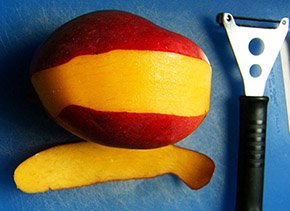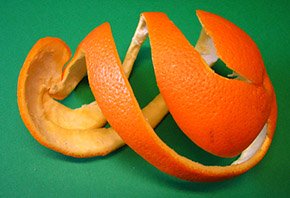Phytonutrients in the Diet
Apart from the major food principles like protein, carbohydrates, and fats, a large number of food items that we consume consist of indispensable components known as phytonutrients or plant-derived chemical substances.
Although their contribution towards total calorific value is insignificant, including these inert compounds in our diet in adequate quantities is imperative. The potential benefits in terms of their direct contribution to health promotion and disease prevention are really enormous.

|
| Mango peel with a fruit peeler. Photo courtesy: ms.Tea |
Changes in lifestyle and dietary patterns have resulted in new world illnesses like irritable bowel syndrome, coronary artery disease, diabetes, stroke, cancers, etc., in higher frequencies than before. Experimental epidemiological studies clearly suggest that the trends in disease patterns are closely linked to the diet we consume.
Consequently, a renewed interest has arisen in the medicinal properties of herbs, spices, vegetables, and fruits, including their peels.

|
| Orange peel. Photo courtesy: fdecomite |
Health benefits of Phytonutrients
Studies have found that certain chemicals other than nutritional principles in them have anti-mutagenic, free-radical scavenging, and immunity-boosting functions, which help promote health and prevent diseases, apart from their nutritive value.
Phytonutrients are present abundantly in the plant world. Examples include:
Antioxidants,
-
Phytosterols (plant sterols),
-
Non-digestible (non-starch) carbohydrates such as tannins, pectin, cellulose, hemicellulose, mucilage, etc.,
-
Natural acids,
-
Enzymes and lecithin.
1. Antioxidants
Studies suggest that cancers occur due to a series of mutational events occurring at the cellular level triggered by free-oxygen radicals and reactive oxygen species (ROS). These free radicals have the ability to damage a cell’s DNA, cell membrane, and proteins like ion channels, receptors, etc.
Antioxidants, by virtue of their reduction potentials, can bind to oxidation radicals at these levels and interrupt free-radical injury by reversing or limiting the extent of the damage.
There are several groups of antioxidants identified such as polyphenolic flavonoids, anthocyanins, etc. Examples of certain antioxidants in fruits and vegetables include:
Lycopene in tomatoes, grapefruit, watermelons, etc,
Anthocyanins in chokeberry, blueberries, broccoli, kale, etc,
Antioxidant vitamins like vitamin-A, E, and C in a large number of herbs, vegetables, and fruits.
2. Plant sterols
Plant sterols, also known as phytosterols, constitute mainly β-sitosterol. Beta-sitosterol is different differs from cholesterol, which is a sterol in humans, in many beneficial ways. Phytosterols absorb poorly in the gut, and during the process, they appear to block the absorption of dietary cholesterol as well; and thus help reduce serum LDL-cholesterol levels.
Initial research studies suggest that experimental doses of plant sterols can be effective in countering the effects of testosterone-mediated hypertrophy in prostate glands (BPH). Again, they help minimize the risk of BPH and prostate cancer in men. Their effects in women, however, appear to be neutral or have some beneficial effect on breast, uterine, and ovarian receptors.
3. Non-digestible carbohydrates, natural acids, and enzymes
The other phytochemicals include detoxifying agents like indoles, isothiocyanates, non-starch polysaccharides (NSP) or dietary-fiber like gums, hemicellulose, mucilage, pectin, tannins,, and alkaloids like caffeine, theobromine, and non-protein amino acids. NSP, also commonly known as dietary fiber, increases the bulk of the food and helps prevent constipation problems by decreasing gastrointestinal transit time. They also bind toxins in the food, prevent their absorption, and help protect the colon mucosa from cancers.
In addition, dietary fibers bind to bile salts (produced from cholesterol) and decrease their re-absorption, thus helping lower serum LDL-cholesterol levels in the blood.
Phytonutrients play a crucial link between health and nutrition. A well-balanced food that is rich in phytonutrients such as fresh fruits, herbs, and vegetables can help minimize free radical and reactive oxygen species (ROS) mediated diseases.
≺≺ Back to Home page.
Further Resources:
Food and Nutrition Information cente- National agricultural library, USDA.
Stanford School of Medicine Cancer information Page- Nutrition to Reduce Cancer Risk. (Link opens in a new window).
Antioxidants and Cancer prevention- National Cancer Institute.